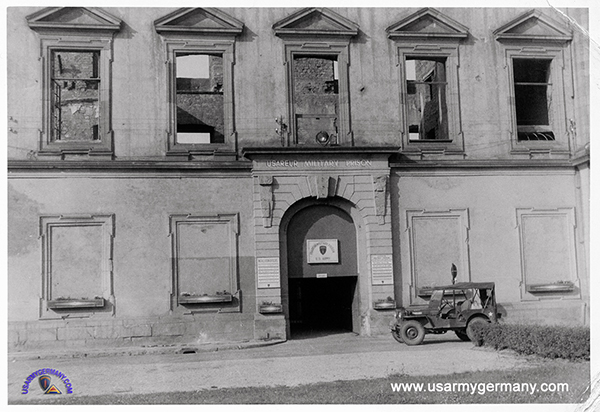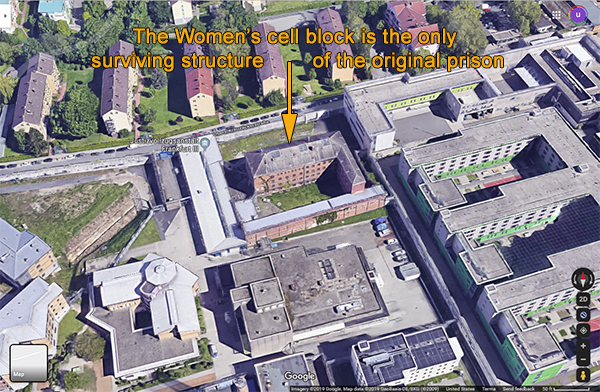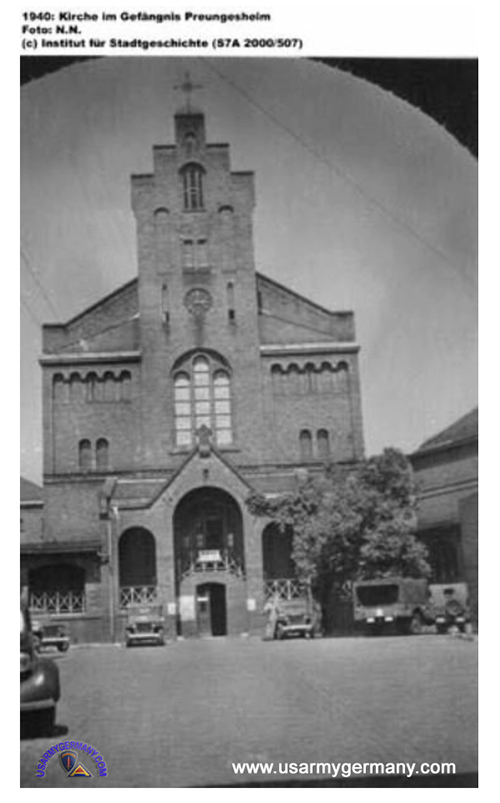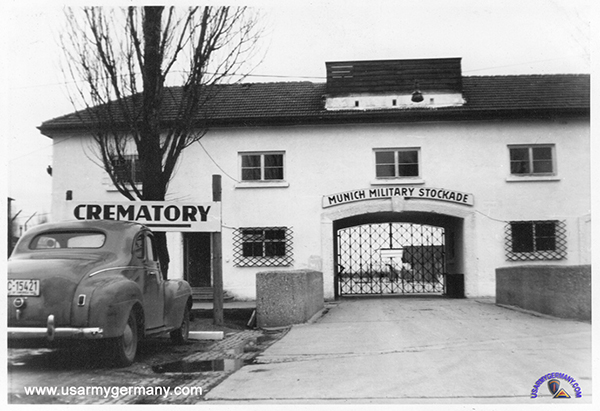| If you do
NOT see the Table of Contents frame to the left of this page, then
Click here to open 'USArmyGermany' frameset |
||||||||
|
Military Police Division |
||||||||
|
|
||||||||
|
||||||||
|
|
||||||||
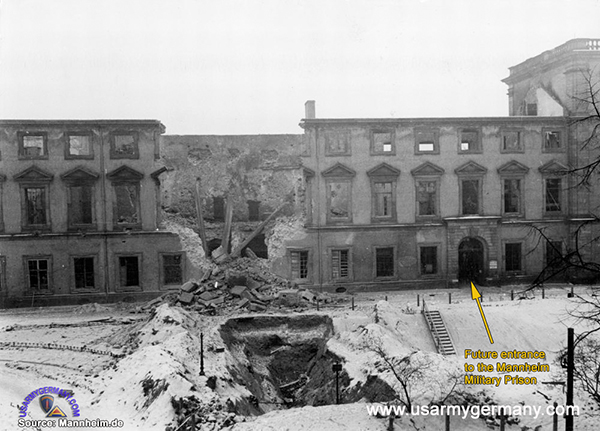 The West Wing of the Mannheim Schloss (future location of the Mannheim Military Prison) in 1945 showing some of the damage caused by Allied bombing during WWII (Mannheim.de) |
||||||||
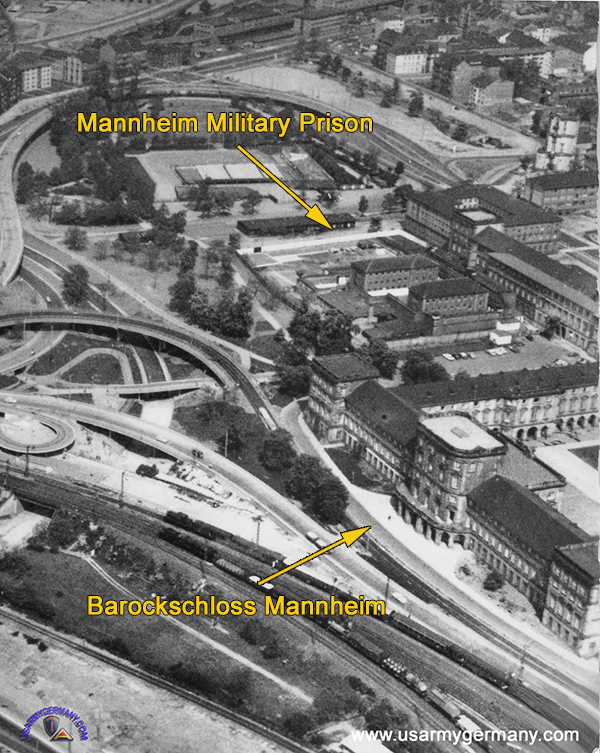 This is a section of a German postcard (undated) that - I believe - shows the former US Army military prison at the Mannheim Schloss. If so, the photo could be from the early to mid-1960s. If anyone has information on the former "Mannheim Military Prison," please contact the webmaster. |
||||||||
| Mannheim Military Prison | ||||||||
| Mannheim Schloss | ||||||||
| 1949 | ||||||||
| (Source: STARS & STRIPES, January 4, 1949) | ||||||||
| Construction of additions to the EUCOM military prison at Mannheim, and improvement of existing facilities there will be completed by Jan. 15, EUCOM announced. The project provides for adding a mess hall, four guard towers, and a dayroom, and painting and repairing the interiors of the main structures. Buildings have been re-wired, perimeter flood lights have been installed, and plumbing fixtures are being repaired. |
||||||||
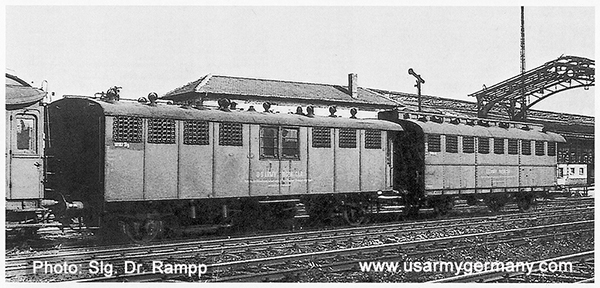 Old style, wooden prison cars used by EUCOM Provost Marshal Division in the 1940s (Photo by Slg Dr. Rampp via Eisenbahn Journal, Germany) |
||||||||
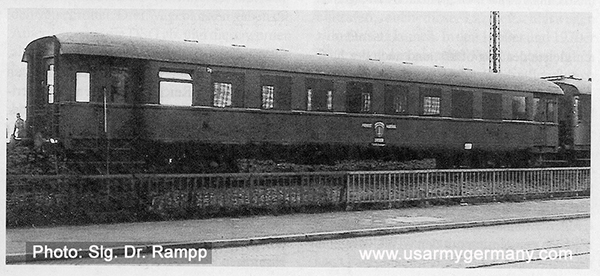 All-steel prison car introduced in 1950 for the Mannheim-Bremerhaven run (Photo by Slg Dr. Rampp via Eisenbahn Journal, Germany) |
||||||||
| 1950 | ||||||||
| (Source: STARS & STRIPES, January 12, 1950) | ||||||||
| New Prison Rail Car Introduced | ||||||||
| A new, all-steel, prison rail car, accommodating 50 to 60 persons, will be placed in service in the U.S. Zone on January 14, 1950. It will be used to transport American prisoners in the U.S.-controlled areas of Germany and Austria. The new car replaces three antiquated wooden coaches with a combined capacity of 27 prisoners. The new prison car assigned to the Provost Marshal Division, EUCOM, was converted from a German passenger coach, at a cost of 11,200 marks, by a rail-car works near Heidelberg. Principle purpose of the car will be transportation of U.S. prisoners from the EUCOM Military Prison Collection Point in Mannheim to Bremerhaven for shipment by troopship to the U.S. (All prisoners with long-term sentences, and those receiving bad conduct or dishonorable discharges are sent to the U.S.) The interior of the car is partitioned by a meshed steel grill into two prisoner sections. Wooden benches are provided. A grill-enclosed guard compartment is located at each end of the coach and there are two cubicles for unruly prisoners which face one of the guard compartments. Windows are secured with screens of meshed, quarter-inch steel bars, welded to the body of the coach. The outside walls of the new coach bear the Flaming-Sword insignia of EUCOM and the inscription "Provost Marshal Division." This replaces the former designation "Prison Car." Home station of the car will be Mannheim, where the EUCOM Military Prison is located. |
||||||||
| 1957 | ||||||||
| (Source: STARS & STRIPES, March 16, 1957) | ||||||||
| Officials at the USAREUR Stockade have asked Headquarters Area Comd school children for their old toys. The stockade is conducting a program to collect discarded toys to repair them and to distribute them among local German children. Sponsored by the HACom commander and HACom chaplains, the program is a year-round outgrowth of a Christmas project undertaken by stockade personnel last year, officials said. |
||||||||
| 1960 | ||||||||
| (Source: STARS & STRIPES, November 1, 1960) | ||||||||
| The USAREUR Stockade here will be replaced sometime in early 1962, the Army has announced. The present stockade, located in a wing ol the Bismarck Castle (Schloss) here, will be closed, and a new one opened at Coleman Barracks, in Sandhofen, a spokesman said. Work on the new stockade, expected to cost about $800,000, is scheduled to begin this month and be completed by early 1962. Construction of the new stockade will be paid for out of German funds. Local German officials have asked to have the current stockade returned to German use to facilitate castle reconstruction and road construction aimed at streamlining local traffic, it was explained. |
||||||||
| 1963 | ||||||||
| (Source: STARS & STRIPES, November 1, 1960) | ||||||||
| The U.S. Government has returned the full use of the Mannheim Castle to the Federal Republic of Germany. The Mannheim Castle, one of the largest in Europe, took over 40 years to build. It was erected between the years 1720 and 1760, during the reign of the Prince Electors Carl Phillip and Carl Theodor of Palatinate. The castle was badly damaged during World War II. The castle was requisitioned by the U.S. Army for use as a stockade in 1945. A new Army stockade has been constructed at Mannhelm-Blumenau and operations were transferred there in December 1962. The many watch towers, walls and stockade buildings of the old stockade will be torn down in the near future. The Mannheim Castle will be completely restored to its former magnificence and function as a tourist attraction. |
||||||||
| Coleman Barracks, Sandhofen | ||||||||
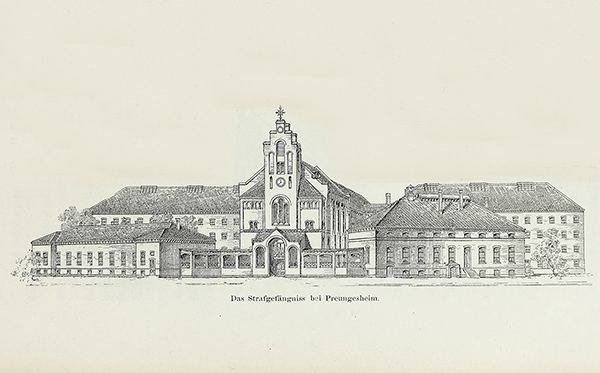 A lithograph from 1886 showing the original Preungesheim prison. The prison chapel is the building in the center with the bell tower (Smithsonian Libraries via Frank Falla Archive) |
||||||||
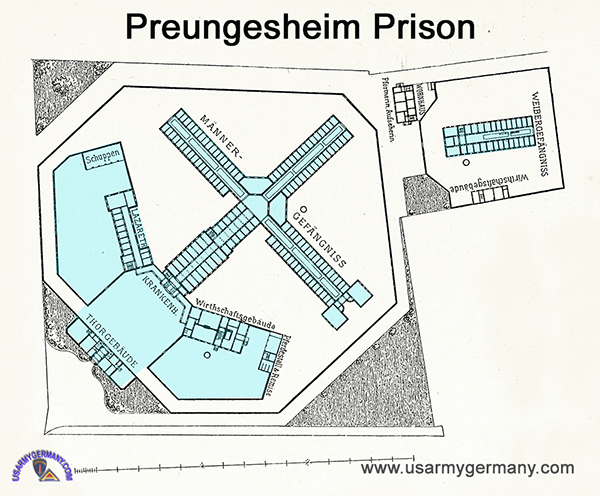 Layout plan of the original Preungesheim prison (Frank Falla Archive) |
||||||||
| Frankfurt Stockade | ||||||||
| 1951 | ||||||||
(Source: STARS & STRIPES, January 28, 1951; Frank Falla Archive - accessed Nov 20, 2019) |
||||||||
The Frankfurt Military Post (FMP) Stockade - located at 112 Homburger Landstrasse in Preungesheim (Frankfurt) - serves as the garrison prison for more than half of the US Army posts in Germany. The prison was built in the 1880's and originally served as a German civil prison. After the Nazi regime seized power in the 1930s, they used it to incarcerate German and foreign political prisoners as well. The capacity of the stockade is 600 but only about 150 prisoners are incarcerated there on an average day. Four watch towers are manned 24 hours a day by guards armed with 12-gauge shotguns. The prisoners include Army personnel and US and Allied civilians who are awaiting trial, confirmation of their sentences, or actually serving sentences of up to one year. There is one other similar stockade in EUCOM, the Nurnberg Military Post stockade which confines prisoners from posts at Nurnberg, Munich, Augsburg and Garmisch. All other prisoners are sent to the Frankfurt stockade. Army prisoners sentenced by court martial to dishonorable or bad conduct discharges are not confined in stockades but at the EUCOM Military Prison in Mannheim. The current (1951) officer in charge of the prison is Capt G. D. Wiethorn. He has a staff of 1 officer and 27 enlisted men. Daily Routine The prisoners rise at 5 AM, have breakfast at 6, and then attend to housekeeping duties, such as putting their cells in order and cleaning prison floors. Many of the prioners then go to work in the prison's carpenter shop where they make crates. Roll call and identification check is held at 5 PM and then the prisoners are locked in their cells with lights out at 9 PM. In addition to the above activities, the prioners participate in 55 hours a week of basic military training and 5 hours of academic training. Courses in English, history and elementary mathematics are taught by FMP Education Center instructors. The prison also has a well stocked library with current books and magazines available during library hours. Every Sunday prisoners may attend devine service in the prison chapel, where services are conducted in all faiths. Food is the same as served in Army messes from the master menu. (Webmaster note: The Preungesheim prison was liberated by US Army troops in late March 1945. The facility was taken over by the Military Government and used by the Army as a military prison until 1953 when it was derequisitioned and returned to the city of Frankfurt.) |
||||||||
| (Source: STARS & STRIPES, November 12, 1951) | ||||||||
HQ EUCOM has initiated a program for rehabilitating soldiers serving guardhouse sentences and leading to their return to duty with, full rights and privileges. Eligible for the rehabilitation program are male prisoners whose sentences do not include a punitive (bad-conduct or dishonorable) discharge, and all prisoners whose sentences are six months or less and include a suspended punitive discharge. |
||||||||
| Munich Stockade | ||||||||
| 1948 | ||||||||
| (Source: STARS & STRIPES, Feb 12, 1948) | ||||||||
|
||||||||
| (Source: STARS & STRIPES, May 23, 1948) | ||||||||
| Effective June 1, all garrison prisoners in the Regensburg Military Post stockade will be confined at the Munich Military Post stockade, Capt. Joseph MacHann, post prison officer, announced. | ||||||||
| Nurnberg Stockade | ||||||||
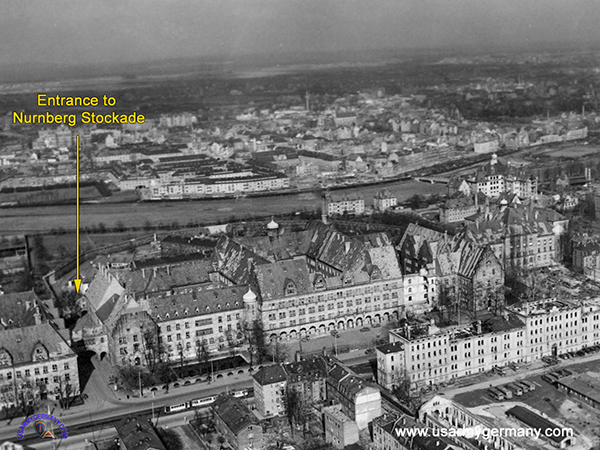 Aerial view (1950s?) of the Palace of Justice and Nurnberg Stockade (Webmaster's collection) |
||||||||
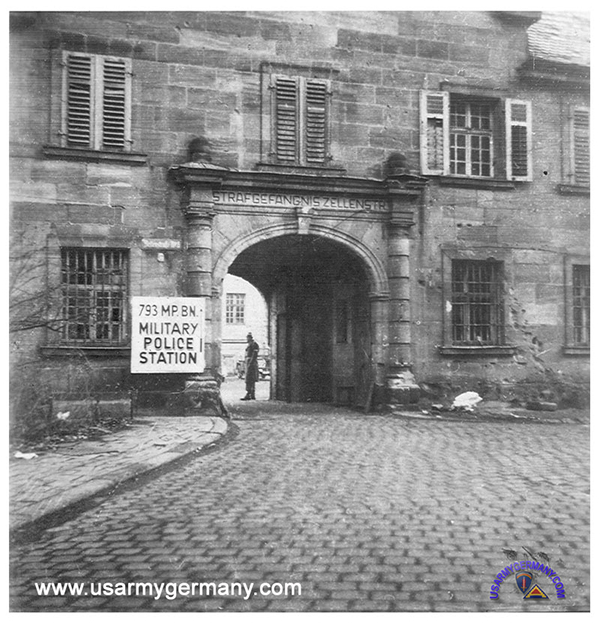 Entrance to the Nurnberg Stockade, 1948 (Webmaster's collection) |
||||||||
| (Source: Nurnberg Military Post Telephone Directory, October 1949) | ||||||||
| The address given for the MP Satation is 8 Zellenstrasse, Nurnberg. (From what I can determine looking at Google Maps, Zellenstrasse is now called Mannertstrasse.) The entrance shown in the photo above is behind the Palace of Justice (Justizpalast) where the Nurnberg Trials were held. According to Wikipedia, the Zellenstrasse Prison was returned to the Germans in 1952. If so, where did the Nurnberg Stockade move to? |
||||||||
| Related Links: | ||||||||

